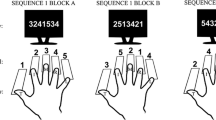Abstract
Before the execution of a sequence of voluntary movements, a memory representation with instructions for the entire sequence is thought to be established in the central nervous system. There are three main sources of support for the existence of such a memory representation, or motor program, as it has been called. First, animals whose sensory feedback systems are impaired can often perform movements skillfully (see Evarts, Bizzi, Burke, Delong, & Thach, 1971; Glencross, 1977; Keele, 1968; Summers, 1981). Second, anticipatory errors in movement production (e.g., Spoonerisms in speech) indicate that information about segments of a sequence may often be available in memory well before the time of their execution (see Fromkin, 1973, 1980; Garrett, 1975, 1982; Norman, 1981). Third, the time to initiate a sequence of movements can depend on characteristics of the sequence, such as its timing (Klapp, 1978; Rosenbaum & Patashnik, 1980a,b) or length (e.g., Henry & Rogers, 1960; Sternberg, Monsell, Knoll, & Wright, 1978).
Access this chapter
Tax calculation will be finalised at checkout
Purchases are for personal use only
Preview
Unable to display preview. Download preview PDF.
Similar content being viewed by others
References
References Notes
Rosenbaum, D.A. Inhoff, A.W., & Gordon, A. Choosing bet2ween movement sequences: A hierarchical editor model. Manuscript submitted for publication, 1983.
Rosenbaum, D.A., & Saltzman, E. Level of choice in the production of movement sequences. Paper presented at the Twenty-third Annual Meeting of the Psychonomic Society, Minneapolis, MN, November 1982.
Klapp, S.T. Personal communication, December 1982.
References
Bertelson, P. S-R relationships and reaction-times to new versus repeated signals in a serial task.Journal of Experimental Psychology, 1963, 65, 478–484.
Bertelson, P. Serial choice reaction-time as a function of response versus signal-and-response repetition.Nature, 1965, 205, 217–218.
Blyth, K.W. Ipsilateral confusion in 2-choice and 4-choice responses with the hands and feet. Nature, 1963, 199, 1312.
Blyth, K.W. Errors in a further four-choice reaction task with the hands and feet. Nature, 1964, 201, 641–642.
Evarts, E.V., Bizzi, E., Burke, R.E., DeLong, M., & Thach, W.T., Jr. Central control of movement. Neurosciences Research Program Bulletin, 1911, 9, 1–169.
Fromkin, V.A. (Ed.) Speech errors as linguistic evidence. The Hague: Mouton, 1973.
Fromkin, V.A. (Ed.) Errors in linguistic performance: Slips of the tongue, ear, pen, and hand. New York: Academic Press, 1980.
Garrett, M.F. The analysis of sentence production. In G.H. Bower (Ed.), Psychology of learning and motivation, (Vol. 6 ). New York: Academic Press, 1975.
Garrett, M.F. Production of speech: Observations from normal and pathological language use. In A. Ellis (Ed.), Normality and pathology in cognitive functions. London: Academic Press, 1982.
Glencross, D.J. Control of skilled movements. Psychological Bulletin, 1977, 84, 14–29.
Henry, F.M., & Rogers, D. Increased response latency for complicated movements and a “memory drum” theory of neuromotor reaction. Research Quarterly, 1960, 31, 448–458.
Heuer, H. Binary choice reaction time as a criterion of motor equivalence. Acta Psychologica, 1982,50, 35–47. (a)
Heuer, H. Binary choice reaction time as a criterion of motor equivalence: Further evidence. Acta Psychologica, 1982,50, 49–60. (b)
Keele, S.W. Movement control in skilled motor performance. Psychological Bulletin, 1968, 70, 387–403.
Kirby, N. Sequential effects in choice reaction time. In A.T. Welford (Ed.), Reaction times. London: Academic Press, 1980.
Klapp, S.T. Reaction time analysis of programmed control. In R. Hutton (Ed.), Exercise and sports sciences reviews, Vol. 5. Santa Barbara, CA: Journal Publishing Affiliates, 1977.
Kornblum, S. Sequential effects in choice reaction time: A tutorial review. In S. Kornblum (Ed.), Attention and performance, (Vol. 4 ). New York: Academic Press, 1973.
Miller, J. Discrete versus continuous stage models of human information processing: In search of partial output. Journal of Experimental Psychology: Human Perception and Performance, 1982, 8, 273–296.
Norman, D.A. Categorization of action slips. Psychological Review, 1981, 88, 1–15.
Rabbitt, P.M.A. Times for transitions between hand and foot responses in a self-paced task. Quarterly Journal of Experimental Psychology, 1966, 18, 334–339.
Rabbitt, P.M.A. Repetition effects and signal classification strategies in serial choice-response tasks. Quarterly Journal of Experimental Psychology, 1968, 20, 232–240.
Rabbitt, P.M.A., & Vyas, S.M. An elementary taxonomy for some errors in laboratory choice RT tasks. Acta Psychologica, 1970, 55, 56–76.
Rosenbaum, D.A. Human movement initiation: Specification of arm, direction, and extent. Journal of Experimental Psychology: General, 1980, 109, 444–474.
Rosenbaum, D.A., Kenny, S., & Derr, M.A. Hierarchical control of rapid movement sequences. Journal of Experimental Psychology: Human Perception and Performance, 1983, 9, 86–102.
Rosenbaum, D.A., & Patashnik, O. A mental clock setting process revealed by reaction times. In G.E. Stelmach & J. Requin (Eds.), Tutorials in motor behavior. Amsterdam: North-Holland, 1980. (a)
Rosenbaum, D.A., & Patashnik, O. Time to time in the human motor system. In R.S. Nickerson (Ed.), Attention and performance VIII. Hillsdale, NJ: Erlbaum, 1980. (b)
Rosenbaum, D.A., Saltzman, E., & Kingman, A. Choosing between movement sequences. In S. Kornblum & J. Requin (Eds.), Preparatory states and processes. Hillsdale, NJ: Erlbaum, 1984.
Sternberg, S., Monsell, S., Knoll, R.L., & Wright, C.E. The latency and duration of rapid movement sequences: Comparisons of speech and typewriting. In G.E. Stelmach (Ed.), Information processing in motor control and learning. New York: Academic Press, 1978.
Summers, J.J. Motor programs. In D.H. Holding (Ed.), Human skills. Chichester, Wiley, 1981.
Editor information
Editors and Affiliations
Rights and permissions
Copyright information
© 1984 Springer-Verlag Berlin Heidelberg
About this chapter
Cite this chapter
Rosenbaum, D.A., Saltzman, E. (1984). A Motor-Program Editor. In: Prinz, W., Sanders, A.F. (eds) Cognition and Motor Processes. Springer, Berlin, Heidelberg. https://doi.org/10.1007/978-3-642-69382-3_4
Download citation
DOI: https://doi.org/10.1007/978-3-642-69382-3_4
Publisher Name: Springer, Berlin, Heidelberg
Print ISBN: 978-3-642-69384-7
Online ISBN: 978-3-642-69382-3
eBook Packages: Springer Book Archive




